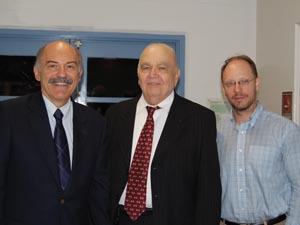Suren Oganessian
Staff Writer

A frequent visitor to the Fresno State campus, Dr. Richard Hovannisian was invited by the Armenian Studies Program to deliver an informative lecture, “Armenian Smyrna” on Friday, October 5, about the terrible inferno that destroyed the Armenian and Greek sections of the city of Smyrna/Izmir in 1922.
Dr. Hovannisian is Professor Emeritus of Armenian and Near Eastern Studies at UCLA, and is a distinguished Chancellor Fellow in Holocaust History, at Chapman University, this fall semester. Dr. Hovannisian’s Armenian Smyrna/Izmir: The Aegean Communities, the eleventh in his series on “Historic Armenian Cities and Provinces,” was recently published.
Dr. Hovannisian began by giving a background of the tragedy that had taken place in Smyrna, a multi-cultural city with large Greek and Armenian, populations. Armenians had been a presence in the city since at least the 13th century as merchants, and the Greeks had lived in the city since antiquity.
Smyrna was a center of Armenian enlightenment during the 1700’s and 1800’s. Its Armenian population was prosperous, producing many goods, such as carpets and figs.
Until 1922 Smyrna had been spared from the ethnic cleansing occurring in the eastern provinces of the Ottoman Empire during World War I and the Armenians and Greeks had found a safe haven there. In 1919, after the war ended and Ottoman Turkey’s defeat, the Greek army was authorized by the allied powers to occupy western Turkey, and Smyrna became the base of their operations.
After the Greeks unsuccessfully tried to enter Ankara in 1922, and were driven back by Turkish nationalist forces, they made a hasty retreat for the Greek islands, leaving Smyrna to be occupied by Turkish forces on September 9. The civilians didn’t feel threatened at first, and thought they would be safe. However, four days later, the Turkish army intentionally set fires in the Armenian quarter—actions that were verified by many eyewitnesses. These fires were carried by the wind into the Greek quarter, causing some 200,000 people to evacuate and seek safety on the docks. Many were then slaughtered by the Turkish army or pushed into the water to drown.
Allied battleships from the United States, Italy, and England were stationed just off shore, but did nothing to help until the next day, when they finally received permission to take refugees on board, thus saving about 6,000 people. Thousands more were forced by the Turkish army to central Turkey, where they were used as a bargaining chip in the population exchange of refugees between Turkey and Greece.
In modern Smyrna, there is barely a hint that the Greek and Armenian quarters ever existed, save for a few buildings that were converted into other uses. Dr. Hovannisian photographed many of these buildings during his visit to the city, and showed photos of the former St. Mesrob School (now a museum).
Dr. Hovannisian expressed hope that as more churches are renovated and more Turkish intellectuals are exploring the dark history of their country, the people of Turkey, as a whole, may someday finally accept the past instead of running from it.
While very tragic, Hovannisian’s lecture was an eye-opening look into one of the final phases of both the Armenian and Greek genocides in Turkey that is rarely discussed.
 Hye Sharzhoom Armenian Action
Hye Sharzhoom Armenian Action